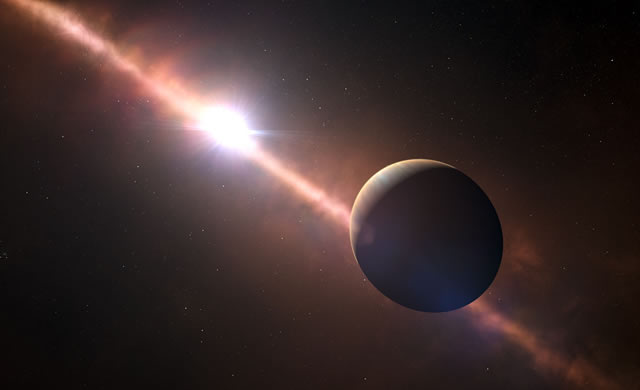
ESO L. Calçada/N. Risinger (skysurvey.org)
Il VLT misura la velocità di rotazione di Beta Pictoris b. Alcune osservazioni con il VLT (Very Large Telescope) dell’ESO hanno determinato, per la prima volta, la velocità di rotazione di un esopianeta. Il giorno di Beta Pictoris b risulta essere di sole otto ore, molto più veloce dei pianeti del Sistema Solare – il suo equatore si muove a quasi 100 000 chilometri all’ora. Questo nuovo risultato estende agli esopianeti la relazione tra la massa e la rotazione osservata nel Sistema Solare. Tecniche simili permetteranno in futuro agli astronomi di produrre mappe dettagliate degli esopianeti con il telescopio E-ELT (European Extremely Large Telescope).
L’esopianeta Beta Pictoris b è in orbita intorno alla stella Beta Pictoris, visibile a occhio nudo, che si trova a circa 63 anni luce dalla Terra nella costellazione australe del Pittore. Questo pianeta è stato scoperto quasi sei anni fa ed è stato uno dei primi esopianeti di cui è stata ottenuta un’immagine diretta. Orbita a una distanza di circa otto volte la distanza Terra-Sole dalla stella madre (eso1024) – diventando così l’esopianeta più vicino a una stella di cui si stata ottenuta l’immagine. Con lo strumento CRIRES installato sul VLT, un’equipe di astronomi olandesi dell’Università di Leida e dell’Istituto olandese per la ricerca spaziale (SRON) hanno scoperto che la velocità di rotazione equatoriale dell’esopianeta Beta Pictoris b è di quasi 100 000 chilometri all’ora. Per confronto, l’equatore di Giove si muove a una velocità di circa 47 000 chilometri all’ora, mentre la Terra si muove a circa 1700 chilometri all’ora. Beta PIctoris b è più di 16 volte più grande e 3000 volte più massiccio della Terra, eppure un giorno sul pianeta dura solo 8 ore. “Non si sa perchè qualche pianeta ruota più velocemente e qualche altro più lentamente”, dice il coautore Remco de Kok, “ma questa prima misura della rotazione di un esopianeta mostra che la tendenza vista nel Sistema Solare, per cui i pianeti più massicci ruotano più velocemente, è vera anche per gli esopianeti. Questa potrebbe essere una conseguenza universale del modo in cui si formano i pianeti.” Beta Pictoris b è un pianeta molto giovane: ha solo 20 milioni di anni, contro i 4,5 miliardi di anni della Terra. Con l’andare del tempo, ci si aspetta che l’esopianeta si raffreddi e rimpicciolisca, cosa che lo farà ruotare ancora più velocemente. D’altra parte, altri processi potrebbero essere in gioco per cambiare la velocità di rotazione del pianeta. Per esempio, la rotazione della Terra sta rallentando nel tempo a causa dell’interazione mareale con la Luna.
Fonte/Leggi tutto → ESO.org
VLT measures the spin of Beta Pictoris b. Observations from ESO’s Very Large Telescope (VLT) have, for the first time, determined the rotation rate of an exoplanet. Beta Pictoris b has been found to have a day that lasts only eight hours. This is much quicker than any planet in the Solar System — its equator is moving at almost 100 000 kilometres per hour. This new result extends the relation between mass and rotation seen in the Solar System to exoplanets. Similar techniques will allow astronomers to map exoplanets in detail in the future with the European Extremely Large Telescope (E-ELT).
Exoplanet Beta Pictoris b orbits the naked-eye star Beta Pictoris, which lies about 63 light-years from Earth in the southern constellation of Pictor (The Painter’s Easel). This planet was discovered nearly six years ago and was one of the first exoplanets to be directly imaged. It orbits its host star at a distance of only eight times the Earth-Sun distance (eso1024) — making it the closest exoplanet to its star ever to be directly imaged. Using the CRIRES instrument on the VLT, a team of Dutch astronomers from Leiden University and the Netherlands Institute for Space Research (SRON) have now found that the equatorial rotation velocity of exoplanet Beta Pictoris b is almost 100 000 kilometres per hour. By comparison, Jupiter’s equator has a velocity of about 47 000 km per hour, while the Earth’s travels at only 1700 km per hour. Beta Pictoris b is more than 16 times larger and 3000 times more massive than the Earth, yet a day on the planet only lasts 8 hours. “It is not known why some planets spin fast and others more slowly,” says co-author Remco de Kok, “but this first measurement of an exoplanet’s rotation shows that the trend seen in the Solar System, where the more massive planets spin faster, also holds true for exoplanets. This must be some universal consequence of the way planets form.” Beta Pictoris b is a very young planet, only about 20 million years old (compared to 4.5 billion years for the Earth). Over time, the exoplanet is expected to cool and shrink, which will make it spin even faster. On the other hand, other processes might be at play that change the spin of the planet. For instance, the spin of the Earth is slowing down over time due to the tidal interactions with our Moon.
Source/Continue reading → ESO.org
Leggi anche/Read also:





















